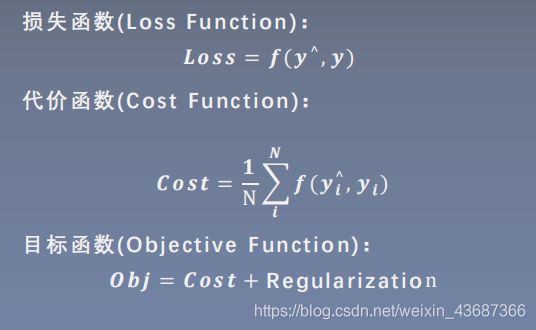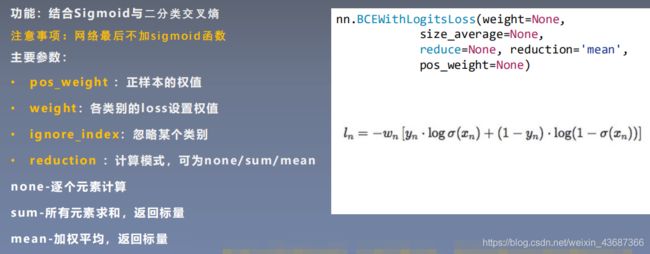Pytorch-18种经典的损失函数
一、18种损失函数
目录:
一、18种损失函数
1、nn.CrossEntropyLoss(交叉熵损失)
2、nn.NLLLoss
3、nn.BCELoss
4、nn.BCEWithLogitsLoss
5、nn.L1Loss
6、nn.MSELoss
7、nn.SmoothL1Loss
8、PoissonNLLLoss
9、nn.KLDivLoss
10、nn.MarginRankingLoss
11、nn.MultiLabelMarginLoss
12、nn.SoftMarginLoss
13、nn.MultiLabelSoftMarginLoss
14、nn.MultiMarginLoss
15、nn.TripletMarginLoss
16、nn.HingeEmbeddingLoss
17、nn.CosineEmbeddingLoss
18、nn.CTCLoss
损失函数:衡量模型输出与真实标签的差异;
目标函数 = 代价函数 + 正则化项(L1或者L2等,惩罚项)
1、nn.CrossEntropyLoss(交叉熵损失)
(1)什么是熵?:熵是信息论中最基本、最核心的一个概念,它衡量了一个概率分布的随机程度,或者说包含的信息量的大小。
具体公式推导可以参考这篇博主的讲解:一文搞懂交叉损失,讲解浅显易懂!
nn.CrossEntropyLoss(weight=None, size_average=None, ignore_index=-100, reduce=None, reduction='mean')
![]() 有weight的
有weight的
(3)代码实现:对应无参数weight的,不同的计算模式下的结果!
import torch
import torch.nn as nn
import torch.nn.functional as F
import numpy as np
# 输入数据
inputs = torch.tensor([[1,2],[1,3],[1,3]],dtype=torch.float)
# print(inputs)
# 对应输入数据的标签
target = torch.tensor([0,1,1],dtype=torch.long)
# print(target)
print("数据:{0},\n标签:{1}".format(inputs,target))数据:tensor([[1., 2.],
[1., 3.],
[1., 3.]]),
标签:tensor([0, 1, 1])# CrossEntropy loss: reduction
"""
reduction有三种计算模式:
1、none-逐个元素计算
2、sum-所有元素求和,返回标量
3、mean-加权平均,返回标量
"""
# flag = 0
flag = 1
if flag:
# 定义损失函数
loss_f_none = nn.CrossEntropyLoss(weight=None,reduction='none')
loss_f_sum = nn.CrossEntropyLoss(weight=None,reduction='sum')
loss_f_mean = nn.CrossEntropyLoss(weight=None,reduction='mean')
# 前向传播
loss_none = loss_f_none(inputs,target)
loss_sum = loss_f_sum(inputs,target)
loss_mean = loss_f_mean(inputs,target)
# 查看输出结果
print("Cross Entropy Loss:\n",loss_none)
print("Cross Entropy Loss:\n",loss_sum)
print("Cross Entropy Loss:\n",loss_mean)
# 手动对上述进行验证
# flag = 0
flag = 1
if flag:
idx = 0
# 将tensor转换为数组
input_1 = inputs.detach().numpy()[idx] # [1,2]数据
target_1 = target.numpy()[idx] # 0标签
# 第一项
x_class = input_1[target_1]
print(x_class)
# 第二项
sigma_exp_x = np.sum(list(map(np.exp,input_1)))
log_sigma_exp_x = np.log(sigma_exp_x)
# 输出loss
loss_1 = -x_class + log_sigma_exp_x
print("第一个样本loss为:",loss_1)Cross Entropy Loss:
tensor([1.3133, 0.1269, 0.1269])
Cross Entropy Loss:
tensor(1.5671)
Cross Entropy Loss:
tensor(0.5224)
1.0
第一个样本loss为: 1.3132617根据系统提供,然后按照手动公式计算,结果是一致的!
# CrossEntropyLoss-------------------有weight参数的------------
# flag = 0
flag = 1
if flag:
# 定义损失函数
weights = torch.tensor([1,2],dtype=torch.float)
loss_f_none_w = nn.CrossEntropyLoss(weight=weights,reduction='none')
loss_f_sum = nn.CrossEntropyLoss(weight=weights,reduction='sum')
loss_f_mean = nn.CrossEntropyLoss(weight=weights,reduction='mean')
loss_none_w = loss_f_none_w(inputs,target)
loss_sum = loss_f_sum(inputs,target)
loss_mean = loss_f_mean(inputs,target)
print("权重参数:{}".format(weights))
print("loss_none_w:{}".format(loss_none_w))
print("loss_sum:{}".format(loss_sum))
print("loss_mean:{}".format(loss_mean))
# 手动计算验证
# flag = 0
flag = 1
if flag:
weights = torch.tensor([1,2],dtype=torch.float)
weights_all = np.sum(list(map(lambda x: weights.numpy()[x],target.numpy())))
mean = 0
loss_sep = loss_none.detach().numpy()
# print(loss_sep)
for i in range(target.shape[0]):
x_class = target.numpy()[i]
tmp = loss_sep[i]*(weights.numpy()[x_class] / weights_all)
mean += tmp
print("loss_mean_by_hand:{}".format(mean))
权重参数:tensor([1., 2.])
loss_none_w:tensor([1.3133, 0.2539, 0.2539])
loss_sum:1.8209737539291382
loss_mean:0.36419475078582764
loss_mean_by_hand:0.36419477313756942、nn.NLLLoss
NLLLoss(weight=None, size_average=None, ignore_index=-100, reduce=None, reduction='mean')
#----------------------------NLLLoss--------------------
# flag = 0
flag = 1
if flag:
weights = torch.tensor([1,1],dtype=torch.float)
loss_f_none_w = nn.NLLLoss(weight=weights,reduction='none')
loss_none_w = loss_f_none_w(inputs,target)
loss_f_sum = nn.NLLLoss(weight=weights,reduction='sum')
loss_sum = loss_f_sum(inputs,target)
loss_f_mean = nn.NLLLoss(weight=weights,reduction='mean')
loss_mean = loss_f_mean(inputs,target)
print("NLLloss:",loss_none_w.numpy(),loss_sum.numpy(),loss_mean.numpy())NLL loss: [-1. -3. -3.] -7.0 -2.33333333、nn.BCELoss
BCELoss(weight=None, size_average=None, reduce=None, reduction='mean')![]()
N代表batch_size
#-----------------------------BCE Loss------------------------------
# flag = 0
flag = 1
if flag:
inputs = torch.tensor([[1, 2], [2, 2], [3, 4], [4, 5]], dtype=torch.float)
target = torch.tensor([[1, 0], [1, 0], [0, 1], [0, 1]], dtype=torch.float)
target_bce = target
# itarget
inputs = torch.sigmoid(inputs)
weights = torch.tensor([1, 1], dtype=torch.float)
loss_f_none_w = nn.BCELoss(weight=weights, reduction='none')
loss_f_sum = nn.BCELoss(weight=weights, reduction='sum')
loss_f_mean = nn.BCELoss(weight=weights, reduction='mean')
# forward
loss_none_w = loss_f_none_w(inputs, target_bce)
loss_sum = loss_f_sum(inputs, target_bce)
loss_mean = loss_f_mean(inputs, target_bce)
# view
print("\nweights: ", weights)
print("BCE Loss", loss_none_w, loss_sum, loss_mean)
#------------------------手动验证----------------------------------
# flag = 0
flag = 1
if flag:
idx = 0
x_i = inputs.detach().numpy()[idx,idx]
y_i = target.numpy()[idx,idx]
#loss
# l_i = -[ y_i * np.log(x_i) + (1-y_i) * np.log(1-y_i) ] # np.log(0) = nan
l_i = -y_i * np.log(x_i) if y_i else -(1-y-i)*np.log(1-x_i)
print("BCE inputs:",inputs)
print("第一个loss为:",l_i)weights: tensor([1., 1.])
BCE Loss tensor([[0.3133, 2.1269],
[0.1269, 2.1269],
[3.0486, 0.0181],
[4.0181, 0.0067]]) tensor(11.7856) tensor(1.4732)
BCE inputs: tensor([[0.7311, 0.8808],
[0.8808, 0.8808],
[0.9526, 0.9820],
[0.9820, 0.9933]])
第一个loss为: 0.313261664、nn.BCEWithLogitsLoss
BCEWithLogitsLoss(weight=None, size_average=None, reduce=None, reduction='mean', pos_weight=None)![]()
![]()
![]()
其中c表示多标签分类数,c表示类别,p_c是肯定正确类别c的权重。
其中N代表batch_size,reduction默认是mean
#-------------------------------BCE with Logis Loss-----------------
# flag = 0
flag = 1
if flag:
inputs = torch.tensor([[1, 2], [2, 2], [3, 4], [4, 5]], dtype=torch.float)
target = torch.tensor([[1, 0], [1, 0], [0, 1], [0, 1]], dtype=torch.float)
target_bce = target
# inputs = torch.sigmoid(inputs)
weights = torch.tensor([1, 1], dtype=torch.float)
loss_f_none_w = nn.BCEWithLogitsLoss(weight=weights, reduction='none')
loss_f_sum = nn.BCEWithLogitsLoss(weight=weights, reduction='sum')
loss_f_mean = nn.BCEWithLogitsLoss(weight=weights, reduction='mean')
# forward
loss_none_w = loss_f_none_w(inputs, target_bce)
loss_sum = loss_f_sum(inputs, target_bce)
loss_mean = loss_f_mean(inputs, target_bce)
# view
print("\nweights: ", weights)
print(loss_none_w, loss_sum, loss_mean)weights: tensor([1., 1.])
tensor([[0.3133, 2.1269],
[0.1269, 2.1269],
[3.0486, 0.0181],
[4.0181, 0.0067]]) tensor(11.7856) tensor(1.4732)上面的pos_weight=None取默认值,通过改变pos_weight查看效果如何
# --------------------------------- pos weight
# flag = 0
flag = 1
if flag:
inputs = torch.tensor([[1, 2], [2, 2], [3, 4], [4, 5]], dtype=torch.float)
target = torch.tensor([[1, 0], [1, 0], [0, 1], [0, 1]], dtype=torch.float)
target_bce = target
# itarget
# inputs = torch.sigmoid(inputs)
weights = torch.tensor([1], dtype=torch.float)
pos_w = torch.tensor([3], dtype=torch.float) # 3
loss_f_none_w = nn.BCEWithLogitsLoss(weight=weights, reduction='none', pos_weight=pos_w)
loss_f_sum = nn.BCEWithLogitsLoss(weight=weights, reduction='sum', pos_weight=pos_w)
loss_f_mean = nn.BCEWithLogitsLoss(weight=weights, reduction='mean', pos_weight=pos_w)
# forward
loss_none_w = loss_f_none_w(inputs, target_bce)
loss_sum = loss_f_sum(inputs, target_bce)
loss_mean = loss_f_mean(inputs, target_bce)
# view
# 指定第一个位置的权重为3,可以和上面没加权重的结果进行对比
print("\npos_weights: ", pos_w)
print(loss_none_w, loss_sum, loss_mean)pos_weights: tensor([3.])
tensor([[0.9398, 2.1269],
[0.3808, 2.1269],
[3.0486, 0.0544],
[4.0181, 0.0201]]) tensor(12.7158) tensor(1.5895)5、nn.L1Loss
L1Loss(size_average=None, reduce=None, reduction='mean')
测量输入:x和目标:y中每个元素之间的平均绝对误差(MAE)
![]()
N代表batch_size,reduction默认是mean
![]()
求和运算仍然对所有元素进行运算,并除以n。如果设置了 reduction ='sum',则可以避免除以:n。
#--------------------L1 loss-----------------------------------
inputs = torch.ones((2,2))
target = torch.ones((2,2))*3
loss_f = nn.L1Loss(reduction='none')
loss = loss_f(inputs,target)
# loss = |input-target|
print("input:{}\ntarget:{}\nL1loss:{}".format(inputs,target,loss))input:tensor([[1., 1.],
[1., 1.]])
target:tensor([[3., 3.],
[3., 3.]])
L1loss:tensor([[2., 2.],
[2., 2.]])6、nn.MSELoss
MSELoss(size_average=None, reduce=None, reduction='mean')
![]()
![]()
关于reduction种的参数设置和nn.L1loss是一样的!
#----------------------MSE loss----------------------------------
inputs = torch.ones((2,2))
target = torch.ones((2,2))*3
loss_f_mse = nn.MSELoss(reduction='none')
loss_mse = loss_f_mse(inputs,target)
print("MSE Loss:{}".format(loss_mse))MSE Loss:tensor([[4., 4.],
[4., 4.]])
7、nn.SmoothL1Loss
是对L1 Loss的一种改进;创建一个使用平方项的标准,如果绝对逐项误差低于1,则使用L1项;否则对异常值的敏感度低于``MSELoss'',并且在某些情况下可以防止梯度爆炸;reduction默认值是均值,和上面几种情况一样!
SmoothL1Loss(size_average=None, reduce=None, reduction='mean')![]()
#--------------------------------SmoothL1Loss-------------------
# 返回一个一维的tensor(张量),这个张量包含了从start到end(包括端点)的等距的steps个数据点。
inputs = torch.linspace(-3,3,steps=500)
# print(inputs)
target = torch.zeros_like(inputs)
# print(target)
import matplotlib.pyplot as plt
loss_f = nn.SmoothL1Loss(reduction='none')
loss_smooth = loss_f(inputs,target)
loss_l1 = np.abs(inputs.numpy())
plt.plot(inputs.numpy(), loss_smooth.numpy(), label='Smooth L1 Loss')
plt.plot(inputs.numpy(), loss_l1, label='L1 loss')
plt.xlabel('x_i - y_i')
plt.ylabel('loss value')
plt.legend()
plt.grid()
plt.show()8、PoissonNLLLoss
功能:泊松分布的负对数似然损失函数;
PoissonNLLLoss(log_input=True, full=False, size_average=None, eps=1e-08, reduce=None, reduction='mean')
![]()
![]()
最后一项可以省略,也可以用斯特林公式近似。 近似值用于大于1的目标值。对于小于或等于1的目标,将零添加到损耗中。
当 log_input=True 时:
![]()
当log_input=False时:
![]()
#------------------------Poisson NLL loss---------------------------------
inputs = torch.randn((2,2))
target = torch.randn((2,2))
loss_f = nn.PoissonNLLLoss(log_input=True,full=False,reduction='none')
loss = loss_f(inputs,target)
print("input:{}\ntarget:{}\nPoisson NLL loss:{}".format(inputs, target, loss))
#-------------------------手动计算验证-------------------------------------
idx = 0
# 这里的计算参考公式
loss_1 = torch.exp(inputs[idx,idx]) - target[idx,idx]*inputs[idx,idx]
print(inputs[idx,idx])
print("第一个元素loss:", loss_1)input:tensor([[-2.2698, 1.6573],
[ 1.9074, 0.3021]])
target:tensor([[ 0.9725, -1.1898],
[-0.5932, -1.1603]])
Poisson NLL loss:tensor([[2.3108, 7.2171],
[7.8672, 1.7031]])
tensor(-2.2698)
第一个元素loss: tensor(2.3108)9、nn.KLDivLoss
KLDivLoss(size_average=None, reduce=None, reduction='mean')KL散度是用于连续分布的有用距离度量,并且在对(离散采样)连续输出分布的空间进行直接回归时通常很有用。
![]()
#-----------------------------------KL Divergence Loss-------------------
inputs = torch.tensor([[0.5, 0.3, 0.2], [0.2, 0.3, 0.5]])
inputs_log = torch.log(inputs)
target = torch.tensor([[0.9, 0.05, 0.05], [0.1, 0.7, 0.2]], dtype=torch.float)
loss_f_none = nn.KLDivLoss(reduction='none')
loss_f_mean = nn.KLDivLoss(reduction='mean')
loss_f_bs_mean = nn.KLDivLoss(reduction='batchmean')
loss_none = loss_f_none(inputs, target)
loss_mean = loss_f_mean(inputs, target)
loss_bs_mean = loss_f_bs_mean(inputs, target)
print("loss_none:\n{}\nloss_mean:\n{}\nloss_bs_mean:\n{}".format(loss_none, loss_mean, loss_bs_mean))
#----------------------------------手动计算验证-------------------------------
idx = 0
# 参考计算公式
loss_1 = target[idx, idx] * (torch.log(target[idx, idx]) - inputs[idx, idx])
print("第一个元素loss:", loss_1)loss_none:
tensor([[-0.5448, -0.1648, -0.1598],
[-0.2503, -0.4597, -0.4219]])
loss_mean:
-0.3335360586643219
loss_bs_mean:
-1.000608205795288
第一个元素loss: tensor(-0.5448)10、nn.MarginRankingLoss
MarginRankingLoss(margin=0.0, size_average=None, reduce=None, reduction='mean')![]()
#-----------------------------Margin ranking Loss------------------------
x1 = torch.tensor([[1], [2], [3]], dtype=torch.float)
x2 = torch.tensor([[2], [2], [2]], dtype=torch.float)
target = torch.tensor([1, 1, -1], dtype=torch.float)
loss_f_none = nn.MarginRankingLoss(margin=0, reduction='none')
loss = loss_f_none(x1, x2, target)
print(loss)tensor([[1., 1., 0.],
[0., 0., 0.],
[0., 0., 1.]])11、nn.MultiLabelMarginLoss
MultiLabelMarginLoss(size_average=None, reduce=None, reduction='mean')
optimizes a multi-class multi-classification hinge loss (margin-based loss) between input :math:`x`(a 2D mini-batch `Tensor`) and output :math:`y` ;
![]()
![]()
![]()
对于所有的 i 和 j 来说;其中x和y的尺寸是相同的;
![]()
#------------------------Multi label Margin loss-------------------
x = torch.tensor([[0.1, 0.2, 0.4, 0.8]])
y = torch.tensor([[0, 3, -1, -1]], dtype=torch.long)
loss_f = nn.MultiLabelMarginLoss(reduction='none')
loss = loss_f(x, y)
print(loss.squeeze().numpy())
#-------------------------手动验证-------------------------------------
x = x[0]
item_1 = (1-(x[0]-x[1])) + (1-(x[0] - x[2])) # y[0]
item_2 = (1-(x[3] - x[1])) + (1 - (x[3] - x[2])) # y[3]
loss_h = (item_1 + item_2) / x.shape[0]
print(loss_h.numpy())0.85
0.8512、nn.SoftMarginLoss
SoftMarginLoss(size_average=None, reduce=None, reduction='mean')功能:计算二分类的logistic损失
主要参数:
- reduction:计算模式,可为none/sum/mean
上述x.nelement()统计张量x中的元素个数;
#---------------------------nn.SoftmarginLoss-------------------
inputs = torch.tensor([[0.3, 0.7], [0.5, 0.5]])
target = torch.tensor([[-1, 1], [1, -1]], dtype=torch.float)
loss_f = nn.SoftMarginLoss(reduction='none')
loss = loss_f(inputs, target)
print("softmarginloss:\n{}".format(loss))
#---------------------------compute by hand------------------------
idx = 1
idx1 = 0
inputs_i = inputs[idx,idx1]
# print(inputs_i)
target_i = target[idx,idx1]
loss_hand = np.log(1+np.exp(-target_i*inputs_i))
print(loss_hand)softmarginloss:
tensor([[0.8544, 0.4032],
[0.4741, 0.9741]])
tensor(0.4741)13、nn.MultiLabelSoftMarginLoss
MultiLabelSoftMarginLoss(weight=None, size_average=None, reduce=None, reduction='mean')
功能:SoftMarginLoss多标签版本
主要参数:
- weight:各类别的loss设置权值
- reduction:计算模式,可为none/sum/mean
其中:
![]()
![]()
#------------------------------------Multi Label Softmargin loss---------------
# help(nn.MultiLabelSoftMarginLoss)
inputs = torch.tensor([[0.3, 0.7, 0.8]])
target = torch.tensor([[0, 1, 1]], dtype=torch.float)
loss_f = nn.MultiLabelSoftMarginLoss(reduction='none')
loss = loss_f(inputs, target)
print("MultiLabel SoftMargin: ", loss)
#------------------------------------------------------------------------
i_0 = torch.log(torch.exp(-inputs[0, 0]) / (1 + torch.exp(-inputs[0, 0])))
i_1 = torch.log(1 / (1 + torch.exp(-inputs[0, 1])))
i_2 = torch.log(1 / (1 + torch.exp(-inputs[0, 2])))
loss_h = (i_0 + i_1 + i_2) / -3
print(loss_h)
MultiLabel SoftMargin: tensor([0.5429]) tensor(0.5429)
14、nn.MultiMarginLoss
MultiLabelMarginLoss(size_average=None, reduce=None, reduction='mean')
功能:计算多分类的折页损失
主要参数:
- P:可选1或2
- weight:各类别的loss设置权值
- margin:边界值
- reduction:计算模式,可为none/sum/mean
![]() ,
,![]() ,
,![]() ,
,![]() ,for all i and j
,for all i and j
# help(nn.MultiLabelMarginLoss)
x = torch.tensor([[0.1, 0.2, 0.7], [0.2, 0.5, 0.3]])
y = torch.tensor([1, 2], dtype=torch.long)
loss_f = nn.MultiMarginLoss(reduction='none')
loss = loss_f(x, y)
print("Multi Margin Loss: ", loss)
#-----------------------------------------------
x = x[0]
margin = 1
i_0 = margin -(x[1] - x[0])
i_2 = margin - (x[1] - x[2])
loss_h = (i_0 + i_2) / x.shape[0]
print(loss_h)Multi Margin Loss: tensor([0.8000, 0.7000]) tensor(0.8000)
15、nn.TripletMarginLoss
TripletMarginLoss(margin=1.0, p=2.0, eps=1e-06, swap=False, size_average=None, reduce=None, reduction='mean')
功能:计算三元组损失,人脸验证中常用;
主要参数:
- P范数的阶,默认为2
- margin:边界值
- reduction:计算模式,可为none/sum/mean
![]()
![]()
其中a,p,n分别表anchor, positive examples and negative examples
# help(nn.TripletMarginLoss)
anchor = torch.tensor([[1.]])
pos = torch.tensor([[2.]])
neg = torch.tensor([[0.5]])
loss_f = nn.TripletMarginLoss(margin=1.0, p=1)
loss = loss_f(anchor, pos, neg)
print("Triplet Margin Loss", loss)
# --------------------------------- compute by hand
margin = 1
a, p, n = anchor[0], pos[0], neg[0]
d_ap = torch.abs(a-p)
d_an = torch.abs(a-n)
loss = d_ap - d_an + margin
print(loss)Triplet Margin Loss tensor(1.5000) tensor([1.5000])
16、nn.HingeEmbeddingLoss
HingeEmbeddingLoss(margin=1.0, size_average=None, reduce=None, reduction='mean')
功能:计算两个输入的相似性,常用于非线性embedding和半监督学习;
特别注意:输入x应为两个输入之差的绝对值
主要参数:
- margin:边界值
- reduction:计算模式,可为none/sum/mean
The loss function for :math: n-th sample in the mini-batch is:
the total loss is: for different reduction
![]()
# help(nn.HingeEmbeddingLoss)
inputs = torch.tensor([[1., 0.8, 0.5]])
target = torch.tensor([[1, 1, -1]])
loss_f = nn.HingeEmbeddingLoss(margin=1, reduction='none')
loss = loss_f(inputs, target)
print("Hinge Embedding Loss", loss)
# --------------------------------- compute by hand
margin = 1.
loss = max(0, margin - inputs.numpy()[0, 2])
print(loss)Hinge Embedding Loss tensor([[1.0000, 0.8000, 0.5000]]) 0.5
17、nn.CosineEmbeddingLoss
CosineEmbeddingLoss(margin=0.0, size_average=None, reduce=None, reduction='mean')
功能:采用余弦相似度计算两个输入的相似性
主要参数:
- margin:可取值 [-1,1],推荐为 [0,0.5]
- reduction:计算模式,可为none/sum/mean
# help(nn.CosineEmbeddingLoss)
x1 = torch.tensor([[0.3, 0.5, 0.7], [0.3, 0.5, 0.7]])
x2 = torch.tensor([[0.1, 0.3, 0.5], [0.1, 0.3, 0.5]])
target = torch.tensor([[1, -1]], dtype=torch.float)
loss_f = nn.CosineEmbeddingLoss(margin=0., reduction='none')
loss = loss_f(x1, x2, target)
print("Cosine Embedding Loss", loss)
# --------------------------------- compute by hand
margin = 0.
def cosine(a, b):
numerator = torch.dot(a, b)
denominator = torch.norm(a, 2) * torch.norm(b, 2)
return float(numerator/denominator)
l_1 = 1 - (cosine(x1[0], x2[0]))
l_2 = max(0, cosine(x1[0], x2[0]))
print(l_1, l_2)Cosine Embedding Loss tensor([[0.0167, 0.9833]]) 0.016662120819091797 0.9833378791809082
18、nn.CTCLoss
CTCLoss(blank=0, reduction='mean', zero_infinity=False)
功能:计算CTC损失,解决时序类数据的分类
主要参数:
- blank:blank label
- zero_infinity:无穷大的值或梯度置0
- reduction:计算模式,可为none/sum/mean
# help(nn.CTCLoss)
T = 50 # Input sequence length
C = 20 # Number of classes (including blank)
N = 16 # Batch size
S = 30 # Target sequence length of longest target in batch
S_min = 10 # Minimum target length, for demonstration purposes
# Initialize random batch of input vectors, for *size = (T,N,C)
inputs = torch.randn(T, N, C).log_softmax(2).detach().requires_grad_()
# Initialize random batch of targets (0 = blank, 1:C = classes)
target = torch.randint(low=1, high=C, size=(N, S), dtype=torch.long)
input_lengths = torch.full(size=(N,), fill_value=T, dtype=torch.long)
target_lengths = torch.randint(low=S_min, high=S, size=(N,), dtype=torch.long)
ctc_loss = nn.CTCLoss()
loss = ctc_loss(inputs, target, input_lengths, target_lengths)
print("CTC loss: ", loss)CTC loss: tensor(5.3379, grad_fn=)


![\text{loss}(x, class) = -\log\left(\frac{\exp(x[class])}{\sum_j \exp(x[j])}\right) | = -x[class] + \log\left(\sum_j \exp(x[j])\right)](http://img.e-com-net.com/image/info8/0f37662866964c9da9f6040f5d6a56c1.gif)







![\text{loss}(x, y) = \sum_i \frac{\log(1 + \exp(-y[i]*x[i]))}{\text{x.nelement}()}](http://img.e-com-net.com/image/info8/f5ec28772b734313872ce6bd7508b6fa.gif)
![loss(x, y) = - \frac{1}{C} * \sum_i y[i] * \log((1 + \exp(-x[i]))^{-1}) + (1-y[i]) * \log\left(\frac{\exp(-x[i])}{(1 + \exp(-x[i]))}\right)](http://img.e-com-net.com/image/info8/0a7dc85d2d8645f183156b9089c6ca28.gif)
![\text{loss}(x, y) = \sum_{ij}\frac{\max(0, 1 - (x[y[j]] - x[i]))}{\text{x.size}(0)}](http://img.e-com-net.com/image/info8/956cdb9d123549e8afc0a22d5c4ca164.gif)



